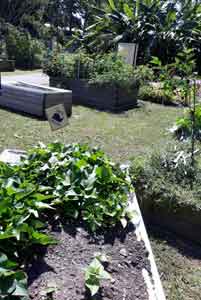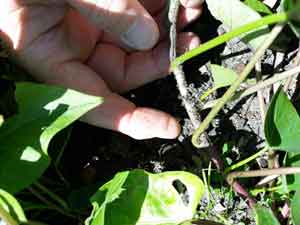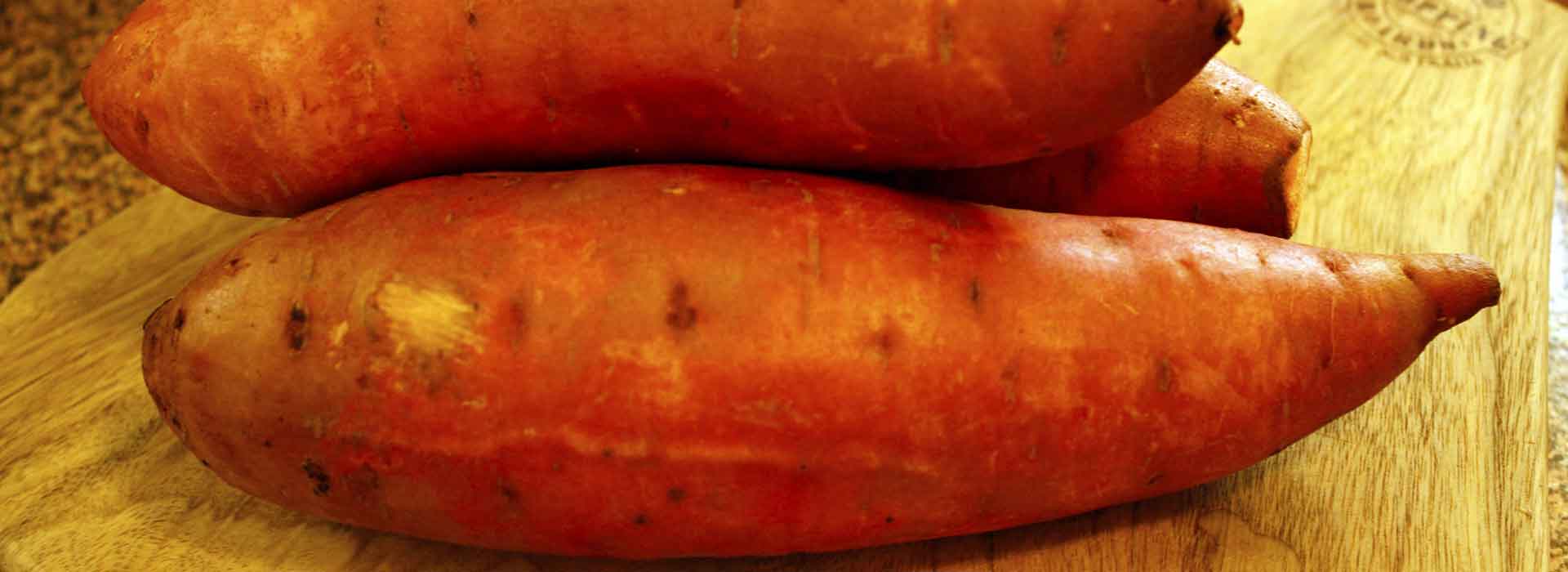Sweet Potato
Sweet potatoes, Ipomoea batatas. are often under-appreciated in the sustainable garden because of their vigorous vines, yet this misunderstood vegetable (neither a potato nor a tuber) has been a staple for many indigenous communities for thousands of years. Some people refer to it as “sweetpotato” to distinguish it from the potato, which is a member of a different plant family.
Starchy root vegetables from the Morning Glory plant family (Convolvulaceae), sweet potatoes are usually distinguished by the colour of their skin and flesh. The vine originated in the tropics of north-western South America. People have been growing ‘kumara’ (the often-used Maori word for sweet potato) since it was first domesticated around 2500 B.C. The Spanish introduced it to Europe and the Portuguese took it to India, Indonesia and Africa. Over 1000 years ago, it was introduced into Samoa and spread across the Pacific.
Planting Schedule
Warm Areas (Queensland, Northern Territory and Western Australia): all year round. In sub-tropics and northern NSW, plant slips (see below for explanation) after the last frost.
Temperate Areas: Plant slips after last frosts in a sheltered position.
Cool to Cold Areas: Plant slips 4 weeks after the last frost in warm, sunny sheltered position.
Varieties
There are four main types grown in Australia and these are distinguished by their colour:
Beauregard – a gold smooth skin with orange flesh – predominant in Australian production (see picture at top of page)
Northern Star – purple skin with white flesh
WSPF or White Skin Purple Flesh – attractive vegetable with soft purple rings of colour inside
Kestle – white skin with white flesh.
The white sweet potato is reported to be a hardier plant, while the gold/orange is sweeter in taste and a better source of Vitamin A. Over the past 20 years, public health experts in Africa have been addressing Vitamin A deficiency by encouraging people to cultivate gold sweet potatoes.
 Position
Position
Sweet potato vines love the sun. They love to meander and fill the bed. In warm areas, they will dominate other plants so it is better to contain the vine in its own bed or tub. Choose a well-drained position.
Soil
This earthy vegetable likes crumbly, loose soil – well composted with organic matter, which helps create a loose, permeable, healthy bed. Sweet potatoes grow best in a sandy loam (approx. proportions sand 53%, silt 43%, and clay 7%) preferably at temperatures above 24 C. Although they need water, do not soak the soil as the vegetables can rot in damp conditions.

Organic fertilizer is best. Be conservative though, as it is better to let the plant send its roots down and allow the vegetables to fill the bed. If you put fertilizer on top of the bed, it will encourage the plant to grow up. So use top fertilizer sparingly and choose one to suit the needs of the soil.
When the vine puts out tiny roots, push them under the soil with your fingers, encouraging the little sprouts to grow down.
Propagation
From Slips
Sweet potatoes are usually grown from slips, prepared from a mature plant. Start with a healthy sweet potato. Cut it in half and place in a glass of water, leaving half the vegetable out of the water and half submerged. Place on a window sill that receives sun or in a warm spot for several weeks until shoots begin to grow on the top. Roots will also grow on the bottom of the vegetable. Carefully cut off each slip (shoot) and immerse in shallow water until a myriad of small roots emerge.
Some gardeners recommend getting the slips by half-burying a sweet potato in moist sand or potting mix. After a few weeks in a warm location many shoots will have appeared. Remove these slips and treat as described above.
Plant slips in a well-prepared bed, angling the slip into a slightly raised mound of earth. Place plants 40-60 cm apart. Water slips every day for the first week and less often as the vines begin to take hold in the earth. Continue to water periodically allowing the earth to stay loose and crumbly. Do not allow compacted ground or drought conditions to impinge on a well-nourished crop.
From Cuttings
You can take cuttings from an established vine. Cut off around 4 cm just above a leaf at the tip of a vine, remove the lower leaves and place in water until roots appear. Or a longer cutting (20-30 cm) can be taken – remove leaves from the lower half and place in the ground, ensuring that soil remains moist.
Timing
In warmer environments, sweet potatoes take approx.16 – 18 weeks to mature; maturing takes longer in cooler climates.
Pests and Disease
Many insects will have a nibble on these nutritious leaves, especially grasshoppers, but unless they are stripping the vine, there is no cause for alarm. This is a sturdy, sometimes virulent, vine that will withstand most pests.
However, especially in hotter climates, the vegetable itself can come under attack by a weevil (Cylas formicarius - Fabricius). This is best avoided by crop rotation, good garden hygiene, involving not using old sweet potatoes to replant the new bed, and the lesser-tested deterrent of being sure to remove alternate wild hosts from your garden or nearby areas e.g. cotton, wild convolvulaceous vines, carrot roots and radish roots and leaves. Choosing varieties that demonstrate resistance might also prove useful.
Harvesting
Pull off the covering vine, saving it to be dug back into the bed as a green manure. Start at the edges of the bed and loosen soil. Sweet potatoes can be easily damaged and can’t be seen until you dig down a little. Using hands or a small pick, work your way into the bed, loosening the soil and freeing the vegetables. Choose those about 20 cm in length. Larger sweet potatoes can be woody.
Storage
It is best not to wash vegetables after harvesting but remove dirt with a dry brush. This prevents rotting from too much moisture. Wrapping in paper can protect sweet potatoes from fungus or insects. Store in a cool, dry place for up to 5 months.
Use
Sweet potatoes have nutritional value (protein, fiber, Vitamin C and calcium), and a low GI rating. Both young and mature leaves have significant amounts of Vitamin B6. Leaves can be added to a stir fry like spinach. Try frying with garlic for an added boost as they pick up other flavours. Recommended spice for accompaniment is cumin.
Recipe

 Sweet potato pie has been a favourite in our family for many years. Here is our family recipe, which works just as well without the butter.
Sweet potato pie has been a favourite in our family for many years. Here is our family recipe, which works just as well without the butter.
Dark Sugar Sweet potato pie
Ingredients
3 medium size (about a 1kg) Beauregard sweetpotatoes (choose firm, smooth vegetables)
½ cup unsalted butter (room temp) (optional)
½ cup dark Muscovado sugar or dark brown sugar
½ cup thickened cream
2 large free range eggs
2 tablespoons SR flour
1 teaspoon pure vanilla extract
1 teaspoon ground cinnamon
½ teaspoon nutmeg
1 teaspoon grated fresh ginger
Pastry
Use a homemade short-crust pastry or ready-made short-crust pastry. Blind bake pastry for 10 minutes in 180 C. (fan forced) oven.
Sweet Potato filling
Peel and cut sweet potatoes into small chunks. Steam until soft; then mash. Place in a blender. Add sugar, vanilla, spices and butter, while sweet potatoes are still warm. Blend. Cool mixture and then add flour, cream and eggs. Blend until smooth and creamy (3 mins). Remove pastry from oven and pour in custard. Return to oven and bake at 170 (fan forced) for an hour. Remove pie from oven when skewer comes out clean. It can still be a little moist and jiggly in the centre. Cool for 1 hour. Serve with yogurt or cream to taste.
Text and photos: Jessica Syme
Jessica Syme lives on the Gold Coast, Queensland. She writes across a range of publications on Travel, Sustainable Architecture and Design. Jessica has a passionate interest in sustainable living and community gardens.
References:
Additional Alternate Hosts of the Sweetpotato Weevils https://core.ac.uk/download/pdf/5100455.pdf
Australian Sweetpotatoes growers Inc.
Dept. of Primary Industries and Regional Development, Government of Western Australia; https://www.agric.wa.gov.au/sweet-potato/growing-sweet-potatoes-western-australia
Dept. of Primary Industries, Developing Strategies to contain Sweetpotato weevil https://ausveg.com.au/app/data/technical-insights/docs/VG98002.pdf
Gold Coast City Council Community Gardens: Varsity Lakes Community Garden.
O'Brien, P. The Sweet Potato: Its Origin and Dispersal, American Anthropologist New Series, Vol. 74, No. 3 (Jun., 1972), pp. 342-365.
Sweet Potato NT: https://nt.gov.au/environment/home-gardens/growing-vegetables-at-home/sweet-potato
The Salt: What’s on your Plate https://www.npr.org/sections/thesalt/2012/08/15/158783117/saving-lives-in-africa-with-the-humble-sweet-potato



